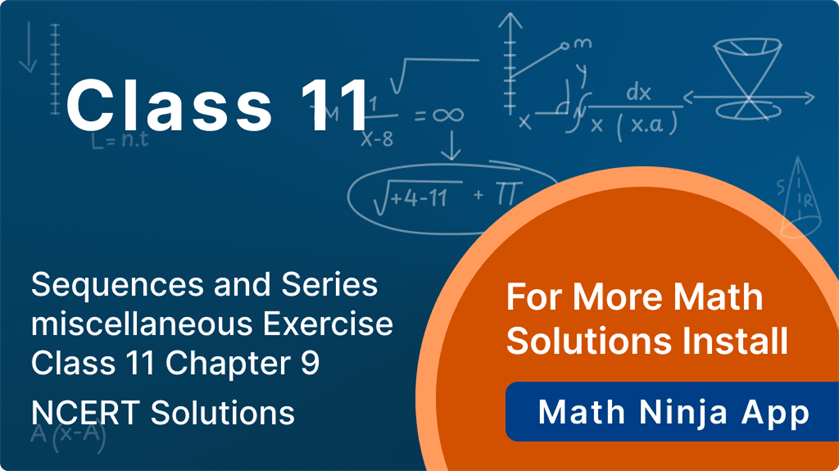Miscellaneous exercise class 11 chapter 9 Sequences and Series | class 11 maths ch 9 miscellaneous exercise solutions | class 11 maths chapter 9 miscellaneous exercise | class 11 maths Sequences and Series | ncert solution for class 11 maths chapter 9 | ncert exemplar class 11 maths
Looking for Miscellaneous Exercise Class 11 Chapter 9 – Sequences and Series solutions? You’re in the right place! This section provides detailed, step-by-step solutions for all questions from the Miscellaneous Exercise of Chapter 9 – Sequences and Series, based on the latest NCERT syllabus. These solutions cover a blend of problems involving Arithmetic Progressions (AP), Geometric Progressions (GP), and special series, helping you apply concepts to more complex and mixed questions. Whether you’re practicing from the Class 11 Maths Ch 9 Miscellaneous Exercise solutions, revising with the NCERT Exemplar Class 11 Maths, or building a deeper understanding of Sequences and Series Class 11, these answers will guide you confidently. View or download the complete NCERT Solution for Class 11 Maths Chapter 9 and strengthen your problem-solving skills today!

class 11 maths chapter 9 miscellaneous exercise || ncert solution for class 11 maths chapter 9 || class 11 maths ch 9 miscellaneous exercise solutions || miscellaneous exercise class 11 chapter 9 Sequences and Series || ncert exemplar class 11 maths || class 11 maths Sequences and Series
Miscellaneous Exercise
\(a_{k}={a}+({k}-1) {d}\)
\(\therefore {a}_{{m}+{n}}={a}+({m}+{n}-1) {d}\)
\({a}_{{m}-{n}}={a}+({m}-{n}-1) {d}\)
\({a}_{{m}}={a}+({m}-1) {d}\)
\(\therefore {a}_{{m}+{n}}+{a}_{{m}-{n}}={a}+({m}+{n}-1) {d}+{a}+({m}-{n}-1) {d}\)
\(=2 {a}+({m}+{n}-1+{m}-{n}-1) {d}\)
\(=2 {a}+(2 {m}-2) {d}\)
\(=2 {a}+2({m}-1) {d}\)
\(=2[{a}+({m}-1) {d}]\)
\(=2 {am}\)
Thus, the sum of \( (m+n)^{\text {th}} \) and \( (m-n)^{\text {th}} \) terms of an A.P. is equal to twice the \( m^{\text {th}} \) term.
According to the given information,
\((a-d)+(a)+(a+d)=24 \ldots(1)\)
\(\Rightarrow 3 a=24\)
\(\therefore a=8\)
\((a-d) a(a+d)=440 \ldots(2)\)
\(\Rightarrow(8-d)(8)(8+d)=440\)
\(\Rightarrow(8-d)(8+d)=55\)
\(\Rightarrow 64-d^{2}=55\)
\(\Rightarrow d^{2}=64-55=9\)
\(\Rightarrow d= \pm 3\)
Therefore, when \( d=3 \), the numbers are 5, 8, and 11 and when \( d=-3 \), the numbers are 11, 8, and 5. 584
Thus, the three numbers are 5, 8, and 11.
\(S_{1}=\frac{n}{2}[2 a+(n-1) d] \ldots(1)\)
\(S_{2}=\frac{2 n}{2}[2 a+(2 n-1) d]=n[2 a+(2 n-1) d] \ldots(2)\)
\(S_{3}=\frac{3 n}{2}[2 a+(3 n-1) d] \ldots(3)\)
From (1) and (2), we obtain
\(\left.\left.{S}_{2}-{S}_{1}={n}[2 {a}++(2 {n}-1) {d})\right]-\frac{n}{2}[2 {a}+({n}-1) {d})\right]\)
\(={n}\left\{\frac{4 a+4 n d-2 d-2 a-n d+d}{2}\right\}\)
\(={n}\left\{\frac{2 a+3 n d-d}{2}\right\}\)
\(=\frac{n}{2}[\left(2 a+93 n-1) d\right]\)
\(\therefore 3\left({S}_{2}-{S}_{1}\right)=\frac{3 n}{2}[2 {a}+(3 {n}-1) {d}]={S}_{3}\quad[\text {from }(3)]\)
Hence, the given result is proved.
\( \therefore \) First term, \( {a}=203 \)
Last term, \( 1=399 \)
Common difference, \( {d}=7 \)
Let the number of terms of the A.P. be \( n \).
\(\therefore {a}_{{n}}=399={a}+({n}-1) {d}\)
\(\Rightarrow 399=203+({n}-1) 7\)
\(\Rightarrow 7({n}-1)=196\)
\(\Rightarrow {n}-1=28\)
\(\Rightarrow {n}=29\)
\({S}_{29}=\frac{29}{2}(203+399)\)
\(=\frac{29}{2}(602)\)
\(=(29)(602)\)
\(=8729\)
Thus, the required sum is \(8729 \).
This forms an A.P. with both the first term and common difference equal to 2.
\(\Rightarrow 100=2+({n}-1)^{2}\)
\(\Rightarrow {n}=50\)
\(\therefore 2+4+6+\ldots+100=\frac{50}{2}[2(2)+(50-1)(2)]\)
\(=\frac{50}{2}[4+98]\)
\(=(25)(102)\)
\(=2550\)
The integers from 1 to 100, which are divisible by 5, are \( 5,10 \ldots 100 \).
This forms an A.P. with both the first term and common difference equal to 5.
\(\therefore 100=5+({n}-1)^{5}\)
\(\Rightarrow 5 {n}=100\)
\(\Rightarrow {n}=20\)
\(\therefore 5+10+\ldots+100=\frac{20}{2}[2(5)+(20-1) 5]\)
\(=10[10+(19) 5]\)
\(=10[10+95]=10 \times 105\)
\(=1050\)
The integers, which are divisible by both 2 and 5, are \( 10,20, \ldots 100 \).
This also forms an A.P. with both the first term and common difference equal to 10.
\(\therefore 100=10+({n}-1)(10)\)
\(\Rightarrow 100=10 {n}\)
\(\Rightarrow {n}=10\)
\(\therefore 10+20+\ldots+100=\frac{10}{2}[2(10)+(10-1)(10)]\)
\(=5[20+90]=5[110]=550\)
Required sum \( =2550+1050-550=3050 \)
Thus, the sum of the integers from 1 to 100, which are divisible by 2 or 5, is 3050.
This series forms an A.P. with first term 13 and common difference 4.
Let \( n \) be the number of terms of the A.P.
It is known that the nth term of an A.P. is given by, \( a n=a+(n-1) d \)
\(\therefore 97=13+({n}-1)(4)\)
\(\Rightarrow 4({n}-1)=84\)
\(\Rightarrow {n}-1=21\)
\(\Rightarrow {n}=22\)
Sum of \( n \) terms of an A.P. is given by,
\({S}_{{n}}=\frac{n}{2}[2 a+(n-1) d]\)
\({S}_{22}=\frac{22}{2}[22(13)+(22-1)(4)]\)
\(=11[26+84]\)
\(=1210\)
Thus, the required sum is 1210.
\( f(x+y)=f(x) \times f(y) \) for all \( x, y \in N\quad \ldots\ldots\text{(1)} \)
\( {f}(1)=3 \)
Taking \( x=y=1 \) in (1),
we obtain \( {f}(1+1)={f}(2)={f}(1) {f}(1)=3 \times 3=9 \)
Similarly,
\( {f}(1+1+1)={f}(3)={f}(1+2)={f}(1) {f}(2)=3 \times 9=27 \)
\( {f}(4)={f}(1+3)={f}(1) {f}(3)=3 \times 27=81 \)
\( \therefore {f}(1), {f}(2), {f}(3), \ldots \), that is \( 3,9,27, \ldots \), forms a G.P. with both the first term and common ratio equal to \(3 \).
It is known that, \( {Sn}=\frac{a\left(r^{n}-1\right)}{r-1} \)
It is given that, \( \sum_{x=1}^{n} f(x)=120 \)
\(=120=\frac{3\left(3^{n}-1\right)}{3-1}\)
\(=120=\frac{3}{2}\left(3^{n}-1\right)\)
\(=3 n-1=80\)
\(=3 n=81=34\)
\(=n=4\)
Thus, the value of n is \(4 \).
It is known that, \( {S}_{{n}}=\frac{a\left(r^{n}-1\right)}{r-1} \)
It is given that the first term a is 5 and common ratio \( r \) is \(2 \).
\(\therefore 315=\frac{5\left(2^{n}-1\right)}{2-1}\)
\(=2 {n}-1=63\)
\(=2 {n}=64=(2)^{6}\)
\(={n}=6\)
Last term of the G.P \( =6^{\text {th}} \) term \( =ar^{6-1}=(5)(2)^{5}=(5)(32)=160 \)
Thus, the last term of the G.P. is \(160 \).
class 11 maths chapter 9 miscellaneous exercise || ncert solution for class 11 maths chapter 9 || class 11 maths ch 9 miscellaneous exercise solutions || miscellaneous exercise class 11 chapter 9 Sequences and Series || ncert exemplar class 11 maths || class 11 maths Sequences and Series
\(a=1 a_{3}=a r^{2}=r^{2} a^{5}=a r^{4}=r^{4}\)
\(\therefore r^{2}+r^{4}=90\)
\(\Rightarrow r^{4}+r^{2}-90=0\)
\(=r^{2}=\frac{-1 \pm \sqrt{1+360}}{2}=\frac{-1 \pm \sqrt{361}}{2}=\frac{-1 \pm 19}{2}=-10 \text { or } 9\)
\(=r \pm 3 \text { (taking real roots) }\)
Thus, the common ratio of the G.P. is \( \pm 3 \).
From the given condition,
\({a}+a {r}+{ar}^{2}=56\)
\(\Rightarrow {a}\left(1+{r}+{r}^{2}\right)=56 \quad \ldots\ldots\text{(1)}\)
\({a}-1, a {r}-7, {ar}^{2}-21 \text { forms an A.P. }\)
\(\therefore(a r-7)-({a}-1)=\left({ar}^{2}-21\right)-(a r-7)\)
\(\Rightarrow a {r}-{a}-6={ar}^{2}-a {r}-14\)
\(\Rightarrow {ar}^{2}-2 {ar}+{a}=8\)
\(\Rightarrow {ar}^{2}-a {r}-{ar}+{a}=8\)
\(\Rightarrow {a}\left({r}^{2}+1-2 {r}\right)=8\)
\(\Rightarrow {a}({r}-1)^{2}=8\quad \ldots\ldots\text{(2)}\)
From (1) and (2), we get
\(\Rightarrow 7\left({r}^{2}-2 {r}+1\right)=1+{r}+{r}^{2}\)
\(\Rightarrow 7 {r}^{2}-14 {r}+7-1-{r}-{r}^{2}=0\)
\(\Rightarrow 6 {r}^{2}-15 {r}+6=0\)
\(\Rightarrow 6 {r}^{2}-12 {r}-3 {r}+6=0\)
\(\Rightarrow 6 {r}({r}-2)-3({r}-2)=0\)
\(\Rightarrow(6 {r}-3)({r}-2)=0\)
When \( {r}=2, {a}=8 \)
When
Therefore, when \( {r}=2 \), the three numbers in G.P. are 8, 16, and 32.
When, \( {r}=\frac{ 1 }{ 2 } \), the three numbers in G.P. are 32, 16, and 8.
Thus, in either case, the three required numbers are 8, 16, and 32.
Number of terms \( =2 {n} \)
According to the given condition,
\({T}_{1}+{T}_{2}+{T}_{3}+\ldots+{T}_{2 {n}}=5\left[{T}_{1}+{T}_{3}+\ldots+{T}_{2 {n}-1}\right]\)
\(\Rightarrow {T}_{1}+{T}_{2}+{T}_{3}+\ldots+{T}_{2 {n}}-5\left[{T}_{1}+{T}_{3}+\ldots+{T}_{2 {n}-1}\right]=0\)
\(\Rightarrow {T}_{2}+{T}_{4}+\ldots+{T}_{2 {n}}=4\left[{T}_{1}+{T}_{3}+\ldots+{T}_{2 {n}-1}\right]\)
Let the G.P. be a, \( a r, a r^{2}, a r^{3} \ldots \)
\(\therefore \frac{\operatorname{ar}\left(r^{n}-1\right)}{r-1}=\frac{4 \times a\left(r^{n}-1\right)}{r-1}\)
\(=a {r}=4 {a}\)
\(={r}=4\)
Thus, the common ratio of the G.P. is 4.
Sum of first four terms \( =a+(a+d)+(a+2 d) +(a+3 d)=4 a+6 d \)
Sum of last four terms
\(=[a+(n-4) d]+[a+(n-3) d]+[a+(n-2) d]+[a+(n-1) d]\)
\(=4 a+(4 n-10) d\)
According to the given condition,
\(4 {a}+6 {d}=56\)
\(\Rightarrow 4(11)+6 {d}=56\quad[\text {Since } {a}=11 \text { (given)}]\)
\(\Rightarrow 6 {d}=12\)
\(\Rightarrow {d}=2\)
\(\therefore 4 {a}+(4 {n}-10) {d}=112\)
\(\Rightarrow 4(11)+(4 {n}-10)^{2}=112\)
\(\Rightarrow(4 {n}-10)^{2}=68\)
\(\Rightarrow 4 {n}-10=34\)
\(\Rightarrow 4 {n}=44\)
\(\Rightarrow {n}=11\)
Thus, the number of terms of the A.P. is 11.
\(\frac{a+b x}{a-b x}=\frac{b+c x}{b-c x}\)
\(=({a}+b {x})({b}-{cx})=({b}+{cx})({a}-{bx})\)
\(={ab}-a c x+{b}^{2} {x}-{bcx}^{2}={ab}-{b}^{2} {x}+a c x-{bcx}^{2}\)
\(=2 {b}^{2} {x}=2 {acx}\)
\(={b}^{2}={ac}\)
\(=\frac{b}{a}=\frac{c}{b} \ldots(1)\)
Also, \( \frac{b+c x}{b-c x}=\frac{c+d x}{c-d x} \)
\(=({b}+{cx})({c}-{dx})=({b}-{cx})({c}+{dx})\)
\(=b c-b d x+{c}^{2} {x}-{cdx}^{2}=b c+b d x-{c}^{2} {x}+{cdx}^{2}\)
\(=2 {c}^{2} {x}=2 {bdx}\)
\(={c}^{2}=b d\)
\(=\frac{c}{d}=\frac{b}{c} \ldots(2)\)
From (1) and (2), we obtain
\(=\frac{b}{a}=\frac{c}{b}=\frac{d}{c}\)
Thus, \( a, b, c \), and dare in G.P.
The \(n^{th}\) term of an A.P. is given by, \( {an}={t}+({n}-1) {d} \)
Therefore,
\(=a_{{p}}={t}+({p}-1) {d}={a} \ldots(1)\)
\(=a_{{q}}={t}+({p}-1) {d}={b} \ldots(2)\)
\(=a_{{r}}={t}+({r}-1) {d}={c} \ldots(3)\)
Subtracting eq. (2) from (1), we obtain
\(({p}-1-{q}+1) {d}={a}-{b}\)
\(=({p}-{q}) {d}={a}-{b}\)
\(={d}=\frac{a-b}{p-q} \ldots (4)\)
Subtracting eq. (3) from (2), we obtain
\(({q}-1-{r}+1) {d}={b}-{c}\)
\(=({q}-{r}) {d}={b}-{c}\)
\(={d}=\frac{b-c}{q-r} \ldots (5)\)
Equating both the values of d obtained in (4) and (5), we obtain
\(=\frac{a-b}{p-q}=\frac{b-c}{q-r}\)
\(=({a}-{b})({q}-{r})=({b}-{c})({p}-{q})\)
\(=a q-a r-b q+b r=b p-b q-c p+c q\)
\(=b p-c p+c q-a q+a r-b r=0\)
\(=(-a q+a r)+(b p-b r)+(-c p+c q)=0 \text { [by rearranging terms] }\)
\(=-a(q-r)-b(r-p)-c(p-q)=0\)
\(=a(q-r)+b(r-p)+c(p-q)=0\)
Thus, the given result is proved.
\({b}\left(\frac{1}{c}+\frac{1}{a}\right)-a\left(\frac{1}{b}+\frac{1}{c}\right)=c\left(\frac{1}{a}+\frac{1}{b}\right)-b\left(\frac{1}{c}+\frac{1}{a}\right)\)
\(=\frac{b(a+c)}{a c}-\frac{a(b+c)}{b c}=\frac{c(a+b)}{a b}-\frac{b(a+c)}{a c}\)
\(=\frac{b^{2} a+b^{2} c-a^{2} b-a^{2} c}{a b c}=\frac{c^{2} a+c^{2} b-b^{2} a-b^{2} c}{a b c}\)
\(={b}^{2} {a}-{a}^{2} {b}+{b}^{2} {c}-{a}^{2} {c}={c}^{2} {a}-{b}^{2} {a}+{c}^{2} {b}-{b}^{2} {c}\)
\(={ab}({b}-{a})+{c}\left({b}^{2}-{a}^{2}\right)={a}\left({c}^{2}-{b}^{2}\right)+b c({c}-{b})\)
\(={ab}({b}-{a})+{c}({b}-{a})({b}+{a})={a}({c}-{b})({c}+{b})+b c({c}-{b})\)
\(=({b}-{a})({ab}+c b+{ca})=({c}-{b})({ac}+{ab}+b c)\)
\(={b}-{a}={c}-{b}\)
Thus, \( a, b \), and \( c \), are in A.P.
\({b}^{2}={ac} \ldots(1)\)
\({c}^{2}=b d \ldots(2)\)
\({ad}=b c \ldots(3)\)
It has to be proved that \( \left({a}^{{n}}+b^{{n}}\right),\left(b^{{n}}+c^{{n}}\right),\left(c^{{n}}+d^{{n}}\right) \) are in G.P. i.e.,
\(=\left(b^{{n}}+c^{{n}}\right)^{2}=\left({an}+b^{{n}}\right)\left(c^{{n}}+d^{{n}}\right)\)
Consider L.H.S.
\(=\left(b^{{n}}+c^{{n}}\right)^{2}={b}^{2} {n}+2 {b}^{2} {cn}+{c}^{2} {n}\)
\(=({ac})^{{n}}+2 {b}^{{n}} {c}^{{n}}+(b d)^{{n}}\quad[\text {using (1) and (2)}] \)
\(={a}^{{n}} c^{{n}}+b^{{n}} c^{{n}}+b^{{n}} c^{{n}}+b^{{n}} d^{{n}}\)
\(={a}^{{n}} c^{{n}}+b^{{n}} c^{{n}}+{a}^{{n}} d^{{n}}+b^{{n}} d^{{n}}\quad[\text {using (3)}]\)
\(=c^{{n}}\left({a}^{{n}}+b^{{n}}\right)+d^{{n}}\left({a}^{{n}}+b^{{n}}\right)\)
\(=\left({a}^{{n}}+b^{{n}}\right)\left(c^{{n}}+d^{{n}}\right) \text { R.H.S. }\)
Thus, \( \left({a}^{{n}}+b^{{n}}\right),\left(b^{{n}}+c^{{n}}\right) \), and \( \left(c^{{n}}+d^{{n}}\right) \) are in G.P.
Prove that \( (q+p):(q-p)=17: 15 \).
\( {a}+{b}=3 \) and \( {ab}={p} \quad \ldots\ldots\text{(1)} \)
Also, \( c \) and \( d \) are the roots of \( x^{2}-12 x+q=0 \)
\( {c}+{d}=12 \) and \( {cd}={q} \quad \ldots\ldots\text{(2)}\)
It is given that \( a, b, c, d \), are in G.P.
Let \( {a}={x}, {b}=x {r}, {c}={xr}^{2}, {d}={xr}^{3} \) from (1) and (2)
We obtain \( x+x r=3={x}(1+{r})=3 \)
\( ={xr}^{2}+{xr}^{3}=12 \)
\( ={xr}^{2}(1+{r})=12 \)
On dividing, we obtain
\(=\frac{x r^{2}(1+r)}{x(1+r)}=\frac{12}{3}\)
\(={r}^{2}=4\)
\(={r}= \pm 2\)
When \( {r}=2, {x}=\frac{3}{1+2}=\frac{3}{3}=1 \)
Where \( r=-2, x=\frac{3}{1-2}=\frac{3}{-1}=-3 \)
Case I
When \( r=2 \) and \( x=1, a b=x^{2} r=2, c d=x^{2} r^{5}=32 \)
\(=\frac{q+p}{q-p}=\frac{32+2}{32-2}=\frac{34}{30}=\frac{17}{15}\)
i.e., \( (q+p):(q-p)=17: 15 \)
case II
When \( r=-2, x=-3, a d=x^{2} r=-18, c d=x^{2} r^{5}=-288 \)
\(=\frac{q+p}{q-p}=\frac{-288-18}{-288+18}=\frac{-306}{-270}=\frac{17}{15}\)
Thus, in both the cases, we obtain \( (q+p):(q-p)=17: 15 \)
A.M. \( =\frac{a+b}{2} \) and G.M. \( =\sqrt{a b} \)
According to the given condition,
\( \frac{a+b}{2 \sqrt{a b}}=\frac{m}{n}\)
\(= \frac{(a+b)^{2}}{4(a b)}=\frac{m^{2}}{n^{2}}\)
\(= (a+b)^{2}=\frac{4 a b m^{2}}{n^{2}}\)
\(= (a+b)=\frac{2 \sqrt{a b} m}{n} \ldots(1)\)
\(= (a-b)^{2}=\frac{4 a b m^{2}}{n^{2}}-4 a b=\frac{4 a b\left(m^{2}-n^{2}\right)}{n^{2}}\)
\(= (a-b)=\frac{2 \sqrt{a b} \sqrt{m^{2}+n^{2}}}{n} \ldots(2)\)
Adding (1) and (2), we obtain
\(2 {a}=\frac{2 \sqrt{a b}}{n}\left(m+\sqrt{m^{2}-n^{2}}\right)\)
\(={a}=\frac{\sqrt{a b}}{n}\left(m+\sqrt{m^{2}-n^{2}}\right)\)
Substituting the value of a in (1), we obtain
\(={b}=\frac{2 \sqrt{a b}}{n} m-\frac{\sqrt{a b}}{n}\left(m+\sqrt{m^{2}-n^{2}}\right)\)
\(=\frac{\sqrt{a b}}{n} m-\frac{\sqrt{a b}}{n} \sqrt{m^{2}-n^{2}}\)
\(=\frac{\sqrt{a b}}{n}\left(m-\sqrt{m^{2}-n^{2}}\right)\)
\(={a}: {b}=\frac{\frac{\sqrt{a b}}{n}\left(m+\sqrt{m^{2}+n^{2}}\right)}{\frac{\sqrt{a b}}{n}\left(m-\sqrt{m^{2}-n^{2}}\right)}=\frac{\left(m+\sqrt{m^{2}+n^{2}}\right)}{\left(m-\sqrt{m^{2}-n^{2}}\right)}\)
Thus, \( {a} ; {b}=\left({m}+\sqrt{m^{2}+n^{2}}\right):\left({m}-\sqrt{m^{2}-n^{2}}\right) \)
\( {b}-{a}={c}-{b} \quad \ldots\ldots\text{(1)}\)
It is given that \( {b}, {c}, {d} \), are in G.P.
\(=c^{2}=b d \quad \ldots\ldots\text{(2)}\)
Also, \( \frac{1}{c}, \frac{1}{d}, \frac{1}{e} \) are in A.P.
\(=\frac{1}{d}-\frac{1}{c}=\frac{1}{e}-\frac{1}{d}\)
\(=\frac{2}{d}=\frac{1}{c}+\frac{1}{e} \quad \ldots\ldots\text{(3)}\)
It has to be proved that \( {a}, {c} , e ,\) are in G.P. i.e., \( {c}^{2}={ae} \)
From (1), we obtain
\(2 b=a+c\)
\(=b=\frac{a+c}{2}\)
From (2), we obtain
\(={d}=\frac{c^{2}}{b}\)
Subtracting this value in (3), we obtain
\(=\frac{2 b}{c^{2}}=\frac{1}{c}+\frac{1}{e}\)
\(=\frac{2(a+c)}{2 c^{2}}=\frac{1}{c}+\frac{1}{e}\)
\(=\frac{a+c}{c^{2}}=\frac{e+c}{e c}\)
\(=\frac{a+c}{c}=\frac{e+c}{e}\)
\(=({a}+{c}) {e}=({e}+{c}) {c}\)
\(={ae}+c e=e c+{c}^{2}\)
\(={c}^{2}={ae}\)
Thus, a, c, and e are in G.P.
20.
class 11 maths chapter 9 miscellaneous exercise || ncert solution for class 11 maths chapter 9 || class 11 maths ch 9 miscellaneous exercise solutions || miscellaneous exercise class 11 chapter 9 Sequences and Series || ncert exemplar class 11 maths || class 11 maths Sequences and Series
Let, \( {Sn}=5+55+555+\ldots \) to n terms
\(=\frac{5}{9}[9+99+999+\ldots \text { to } {n} \text { terms}]\)
\(=\frac{5}{9}\left[(10-1)+\left(10^{2}-1\right)+\left(10^{3}-1\right)+\ldots \text { to n terms}\right]\)
\(=\frac{5}{9}\left[\left(10+10^{2}+10^{3}+\ldots {n} \text { terms }\right)-(1+1+\ldots {n} \text { terms})\right]\)
\(=\frac{5}{9}\left[\frac{\left[10\left(10^{n}-1\right)\right.}{10-1}-n\right]\)
\(=\frac{5}{9}\left[\frac{10\left(10^{n}-1\right)}{9}\right]\)
\(=\frac{50}{81}\left(10^{n}-1\right)-\frac{5 n}{9}\)
Let, \( {Sn}=0.6+0.66+0.666+\ldots \) to n terms
\( =6[0.1+0.11+0.111+\ldots \) to n terms\( ] \)
\(=\frac{6}{9}[0.9+0.99+0.999+\text { to n terms}]\)
\(=\frac{6}{9}\left[\left(1-\frac{1}{10}\right)+\left(1-\frac{1}{10^{2}}\right)+\left(1-\frac{1}{10^{3}}\right)+\cdots \text { to } n \text { terms}\right]\)
\(=\frac{2}{3}\left[(1+1+\cdots n \text { terms})-\frac{1}{10}\left(1+\frac{1}{10}+\frac{1}{10^{2}}+\cdots n\text { terms}\right)\right]\)
\(=\frac{2}{3}\left[n-\frac{1}{10}\left(\frac{1-\left(\frac{1}{10}\right)^{n}}{1-\frac{1}{10}}\right)\right]\)
\(=\frac{2}{3} n-\frac{2}{30} \times \frac{10}{9}\left(1-10^{-n}\right)\)
\(=\frac{2}{3} n-\frac{2}{27}\left(1-10^{-n}\right)\)
\({n}^{\text {th}} \text { term }={a}_{{n}}=2 {n} \times(2 {n}+2)=4 {n}^{2}+4 {n}\)
\({a}_{20}=4(20)^{2}+4(20)=4(400)+80=1600+80=1680\)
Thus, the \( 20^{\text {th}} \) term of the series is 1680.
\(S=3+7+13+21+31+\ldots+a_{n-1}+a_{n}\)
\(S=3+7+13+21+\ldots+a_{n-2}+a_{n-1}+a_{n}\)
On subtracting both the eq., we obtain
\({S}-{S}=\left[3+\left(7+13+2131+\ldots+{a}_{{n}-1}+{a}_{{n}}\right)\right]\)\(-[(3+7+13+21+31+\ldots+{a}_{{n}-1}+{a}_{{n}})]\)
\({S}-{S}=3+\left[(7-3)+(13-7)+(21-13) +\ldots+\left({a}_{{n}}-{a}_{{n}-1}\right)\right]-{a}_{{n}}\)
\(0=3+[4+6+8+\ldots({n}-1) \text { terms}]-{a}_{{n}}\)
\({a}_{{n}}=3+[4+6+8+\ldots({n}-1) \text { terms}]\)
\({a}_{{n}}=3+\left(\frac{n-1}{2}\right)[2 \times 4+({n}-1-1) 2]\)
\(=3+\left(\frac{n-1}{2}\right)[8+({n}-2) 2]\)
\(=3+\left(\frac{n-1}{2}\right)[2 {n}+4]\)
\(=3+({n}-1)({n}-2)\)
\(=3+\left({n}^{2}+{n}-2\right)\)
\(={n}^{2}+{n}+1\)
\(\sum_{k=1}^{n} a_{k}=\sum_{k=1}^{n} k^{2}+\sum_{k=1}^{n} k+\sum_{k=1}^{n} 1\)
\(=\frac{n(n+1)(2 n+1)}{6}+\frac{n(n+1)}{2}+n\)
\(={n}\left[\frac{(n+1)(2 n+1)+3(n+1)+6}{6}\right]\)
\(={n}\left[\frac{2 n^{2}+3 n+1+3 n+3+6}{6}\right]\)
\(={n}\left(\frac{2 n^{2}+6 n+10}{6}\right)\)
\(=\frac{n}{3}\left(n^{2}+3 n+5\right)\)
\({S}_{1}=\frac{n(n+1)}{2}\)
\({S}_{2}=\frac{n^{2}(n+1)^{2}}{4}\)
Here, \( {S}_{3}\left(1+8 {S}_{1}\right)=\frac{n^{2}(n+1)^{2}}{4}\left[1+\frac{8 n(n+1)}{2}\right] \)
\(=\frac{n^{2}(n+1)^{2}}{4}\left[4 n^{2}+4 n+1\right]\)
\(=\frac{n^{2}(n+1)^{2}}{4}(2 n+1)^{2}\)
\(=\frac{[n(n+1)(2 n+1)]^{2}}{4} \ldots(1)\)
Also, \( 9 S_{2}^{2}=9 \frac{[n(n+1)(2 n+1)]^{2}}{6^{2}} \)
\(=\frac{9}{36}[n(n+1)(2 n+1)]^{2}\)
\(=\frac{[n(n+1)(2 n+1)]^{2}}{4} \ldots(2)\)
Thus, from (1) and (2), we obtain \( 9 S_{2}^{2}={S}_{3}\left(1+8 {S}_{1}\right) \)
Here, \( 1,3,5, \ldots(2 {n}-1) \) is an A.P. with first term a, last term \( (2 {n}-1) \) and number of terms as \( n \)
\(=1+3+5+\ldots .+(2 {n}-1)=\frac{n}{2}[2 \times 1+({n}-1) 2]={n}^{2}\)
\({a}_{{n}}=\frac{n^{2}(n+1)^{2}}{4 n^{2}}=\frac{(n+1)^{2}}{4}=\frac{1}{4} n^{2}+\frac{1}{2} n+\frac{1}{4}\)
\({S}_{{n}}=\sum_{k=1}^{a} a_{k}=\sum_{k=1}^{n}\left(\frac{1}{4} k^{2}+\frac{1}{2} k+\frac{1}{4}\right)\)
\(=\frac{1}{4} \frac{n(n+1)(2 n+1)}{6}+\frac{1}{2} \frac{n(n+1)}{2}+\frac{1}{4} n\)
\(=\frac{n[(n+1)(2 n+1)+6(n+1)+6]}{24}\)
\(=\frac{n\left[2 n^{2}+3 n+1+6 n+6+6\right]}{24}\)
\(=\frac{n\left(2 n^{2}+9 n+12\right)}{24}\)
\( {n}^{\text {th}} \) term of the denominator \( ={n}^{2}({n}+1)={n}^{3}+{n}^{2} \)
\(\frac{1 \times 2^{2}+2 \times 3^{2}+\cdots+n \times(n+1)^{2}}{1^{2} \times 2+2^{2} \times 3+\cdots+n^{2} \times(n+1)}=\frac{\sum_{k=1}^{n} n_{k}}{\sum_{k=1}^{n} n_{k}}=\frac{\sum_{k=1}^{n}\left(k^{3}+2 k^{2}+k\right)}{\sum_{k=1}^{n}\left(k^{3}+k^{2}\right)} \ldots(1)\)
Here, \( \sum_{k=1}^{n}\left(k^{3}+2 k^{2}+k\right) \)
\(=\frac{n^{n}(n+1)^{2}}{6}=\frac{2 n(n+1)(2 n+1)}{4}=\frac{n(n+1)}{2}\)
\(=\frac{n(n+1)}{2}\left[\frac{n(n+1)}{2}+\frac{2}{3}(2 n+1)+1\right]\)
\(=\frac{n(n+1)}{2}\left[\frac{3 n^{2}+3 n+8 n+4+6}{6}\right]\)
\(=\frac{n(n+1)}{12}\left[3 n^{2}+11 n+10\right]\)
\(=\frac{n(n+1)}{12}\left[3 n^{2}+6 n+5 n+10\right]\)
\(=\frac{n(n+1)}{12}[3 n(n+2)+5(n+2)]\)
\(=\frac{n(n+1)(n+2)(3 n+5)}{12} \ldots(2)\)
\(\text { Also, } \sum_{k=1}^{n}\left(k^{2}+k^{2}\right)=\frac{n^{2}(n+1)^{2}}{4}+\frac{n(n+1)(2 n+1)}{6}\)
\(=\frac{n(n+1)}{2}\left[\frac{n(n+1)}{2}+\frac{2 n+1}{3}\right]\)
\(=\frac{n(n+1)}{2}\left[\frac{3 n^{2}+3 n+4 n+2}{6}\right]\)
\(=\frac{n(n+1)}{12}\left[3 n^{2}+7 n+2\right]\)
\(=\frac{n(n+1)}{12}\left[3 n^{2}+6 n+n+2\right]\)
\(=\frac{n(n+1)}{12}[3 n(n+2)+1(n+2)]\)
\(=\frac{n(n+1)(n+2)(3 n+1)}{12} \ldots(3)\)
From (1), (2) and (3), we obtain
\(=\frac{1 \times 2^{2}+2 \times 3^{2}+\cdots+n \times(n+1)^{2}}{1^{2} \times 2+2^{2} \times 3+\cdots+n^{2} \times(n+1)}=\frac{\frac{n(n+1)(n+2)(3 n+5)}{12}}{\frac{n(n+1)(n+2)(3 n+1)}{12}}\)
\(=\frac{3 n+5}{3 n+1}\)
Hence, proved.
class 11 maths chapter 9 miscellaneous exercise || ncert solution for class 11 maths chapter 9 || class 11 maths ch 9 miscellaneous exercise solutions || miscellaneous exercise class 11 chapter 9 Sequences and Series || ncert exemplar class 11 maths || class 11 maths Sequences and Series
Therefore, unpaid amount \( =₹ 12000-₹ 6000=₹ 6000 \)
According to the given conditions, the interest paid annually is \( 12 \% \) of \( 6000,12 \% \) of \( 5500,12 \% \) of \( 5000 \ldots 12 \% \) of 500
Thus, total interest to be paid
\(=12 \% \text { of } 6000+12 \% \text { of } 5500+12 \% \text { of } 5000+\ldots+12 \% \text { of } 500\)
\(=12 \% \text { of }(6000+5500+5000+\ldots+500)\)
\(=12 \% \text { of }(500+1000+1500+\ldots+6000)\)
Now, the series \( 500,1000,1500,6000 \) is an A.P. with both the first term and common difference equal to \(500\)
Let, the number of terms of the A.P. be \(n\).
\(6000=500+({n}-1) 500\)
\(=1+({n}-1)=12\)
\(={n}=12\)
Sum of A.P.
\(=\frac{12}{2}[2(500)+(12-1)(500)]=6[1000+5500]=6[6500]=39000\)
Thus total interest to be paid
\(=12 \% \text { of }(500+1000+1500+\ldots+6000))\)
\(=12 \% \text { of } 39000=₹ 4680\)
Thus, cost of tractor \( =(₹ 12000+₹ 4680)=₹ 16680 \)
Unpaid amount \( =₹ 22000-₹ 4000=₹ 18000 \)
According to the given condition, the interest paid annually is \( 10 \% \) of \( 18000,10 \% \) of \( 17000,10 \% \) of \( 16000 \ldots .10 \% \) of 1000 .
Thus, total interest to be paid
\(=10 \% \text { of } 18000,10 \% \text { of } 17000,10 \% \text { of } 16000 \ldots .10 \% \text { of } 1000\)
\(=10 \% \text { of }(18000+17000+16000+\ldots+1000)\)
\(=10 \% \text { of }(1000+200+3000+\ldots+18000)\)
Here, \( 1000,2000,3000 \ldots 18000 \) forms an A.P. with first term and common difference both equal to \(1000\).
Let, the numbers of terms be \( n \).
\(=18000=1000+({n}-1)(1000)\)
\(={n}=18\)
\(1000+2000+\ldots+18000=\frac{18}{2}[2(1000)+(18-1)(1000)]\)
\(=9[2000+17000]\)
\(=171000\)
Total interest paid \( =10 \% \) of \( (18000+17000+16000+\ldots+1000) \)
\( =10 \% \) of ₹ \( 171000= \) ₹ \(17100\)
Cost of scooter \( =₹ 22000+₹ 17100=₹ 39100 \)
First term \( =4 \)
Common ratio \( =4 \)
Numbers of item \( =8 \)
It is known that the sum of n terms of a G.P. is given by
\( {S}_{{n}}=\frac{a\left(r^{n}-1\right)}{1-r} \)
\( {S}_{8}=\frac{4\left(4^{8}-1\right)}{4-1}=\frac{4(65536-1)}{3}=\frac{4(65535)}{3}=4(21845)=87380 \)
It is given that the cost to mail one letter is 50 paisa.
Cost of mailing 87380 letters \( =₹ 87380 \times \frac{50}{100}=₹ 43690 \)
Thus, the amount spent when \( 8^{\text {th}} \) set of letter is mailed is ₹ \(43690 \).
Simple interest annually \( =\frac{5}{100} \times ₹ 10000=₹ 500 \)
Interest in first year \( =10000+500+500+\ldots+500 \)
Amount in \( 15^{\text {th}} \) year \( =₹ \)
\(=₹ 10000+14 \times ₹ 500\)
\(=₹ 10000+₹ 7000\)
\(=₹ 17000\)
Amount after 20 years \( =₹ 10000+500+500+\ldots+500 \)
\(=₹ 10000+20 \times ₹ 500\)
\(=₹ 10000+₹ 10000\)
\( =₹ 20000 \)
Machine depreciates by \( 20 \% \) every year.
Therefore, its value after every year is \( 80 \% \) of the original cost i.e., \( \frac{4}{5} \) of the original cost.
Value at the end of 5 years \( =15625 \times \frac{4}{5} \times \frac{4}{5} \ldots \times \frac{4}{5}=5 \times 1024=5120 \)
Thus, the value of the machine at the end of 5 years is \( ₹=5120 \).
According to the given information,
\( 150 {x}=150+146+142+\ldots({x}+8) \) terms
The series \( 150+146+142+\ldots({x}+8) \) terms is an A.P. with first term \(146\), common differences \(-4\) and number of terms as \(( x+8 )\)
\(=150 {x}=\frac{(x+8)}{2}[2(150)+({x}+8-1)(-4)]\)
\(=150 {x}=({x}+8)[150+({x}+7)(-2)]\)
\(=150 {x}=({x}+8)(150-2 {x}-14)\)
\(=150 x=(x+8)(136-2 x)\)
\(=75 x=69 x-x^{2}+544-8 x\)
\(=x^{2}+15 x-544=0\)
\(=x^{2}+32 x-17 x-544=0\)
\(=x(x+32)-17(x+32)=0\)
\(=(x+32)(x-17)=0\)
\(=x=17 \text { or } x=-32\)
However, \( x \) cannot be
\( = \) negative \( {x}=17 \)
Therefore, originally, the number of days in which the work was completed is \(17 \). Thus, required number of days \( =(17+8)=25 \)
class 11 maths chapter 9 miscellaneous exercise || ncert solution for class 11 maths chapter 9 || class 11 maths ch 9 miscellaneous exercise solutions || miscellaneous exercise class 11 chapter 9 Sequences and Series || ncert exemplar class 11 maths || class 11 maths Sequences and Series
Lorem ipsum dolor sit amet, consectetur adipiscing elit. Ut elit tellus, luctus nec ullamcorper mattis, pulvinar dapibus leo.

